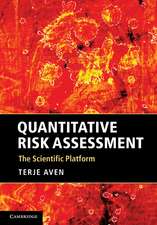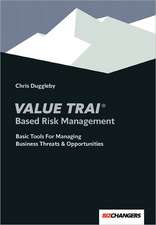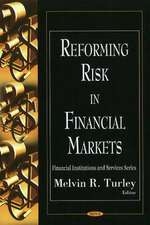Understanding Risk: The Theory and Practice of Financial Risk Management: Chapman and Hall/CRC Financial Mathematics Series
Autor David Murphyen Limba Engleză Hardback – 2 aug 2017
With numerous exercises, figures, and examples throughout, this book offers valuable insight on various aspects of financial risk management.
| Toate formatele și edițiile | Preț | Express |
|---|---|---|
| Paperback (1) | 715.27 lei 6-8 săpt. | |
| CRC Press – 23 apr 2008 | 715.27 lei 6-8 săpt. | |
| Hardback (1) | 1014.74 lei 6-8 săpt. | |
| CRC Press – 2 aug 2017 | 1014.74 lei 6-8 săpt. |
Din seria Chapman and Hall/CRC Financial Mathematics Series
- 9%
 Preț: 641.09 lei
Preț: 641.09 lei - 8%
 Preț: 548.53 lei
Preț: 548.53 lei - 9%
 Preț: 731.00 lei
Preț: 731.00 lei - 8%
 Preț: 459.85 lei
Preț: 459.85 lei - 8%
 Preț: 496.01 lei
Preț: 496.01 lei - 9%
 Preț: 768.94 lei
Preț: 768.94 lei - 9%
 Preț: 704.11 lei
Preț: 704.11 lei - 9%
 Preț: 1213.55 lei
Preț: 1213.55 lei -
 Preț: 356.86 lei
Preț: 356.86 lei - 8%
 Preț: 531.56 lei
Preț: 531.56 lei -
 Preț: 342.36 lei
Preț: 342.36 lei - 9%
 Preț: 716.11 lei
Preț: 716.11 lei - 8%
 Preț: 410.54 lei
Preț: 410.54 lei - 8%
 Preț: 489.58 lei
Preț: 489.58 lei -
 Preț: 364.17 lei
Preț: 364.17 lei -
 Preț: 356.63 lei
Preț: 356.63 lei - 9%
 Preț: 833.51 lei
Preț: 833.51 lei - 9%
 Preț: 609.69 lei
Preț: 609.69 lei - 9%
 Preț: 595.34 lei
Preț: 595.34 lei - 8%
 Preț: 375.01 lei
Preț: 375.01 lei - 9%
 Preț: 574.56 lei
Preț: 574.56 lei -
 Preț: 403.11 lei
Preț: 403.11 lei -
 Preț: 456.76 lei
Preț: 456.76 lei -
 Preț: 436.14 lei
Preț: 436.14 lei - 13%
 Preț: 310.44 lei
Preț: 310.44 lei - 26%
 Preț: 1014.74 lei
Preț: 1014.74 lei - 12%
 Preț: 312.43 lei
Preț: 312.43 lei - 15%
 Preț: 599.94 lei
Preț: 599.94 lei - 18%
 Preț: 783.69 lei
Preț: 783.69 lei - 15%
 Preț: 570.70 lei
Preț: 570.70 lei - 8%
 Preț: 544.80 lei
Preț: 544.80 lei - 18%
 Preț: 793.01 lei
Preț: 793.01 lei - 24%
 Preț: 900.85 lei
Preț: 900.85 lei - 18%
 Preț: 1280.44 lei
Preț: 1280.44 lei - 9%
 Preț: 608.33 lei
Preț: 608.33 lei - 22%
 Preț: 371.11 lei
Preț: 371.11 lei - 20%
 Preț: 508.40 lei
Preț: 508.40 lei - 26%
 Preț: 763.78 lei
Preț: 763.78 lei - 20%
 Preț: 1288.30 lei
Preț: 1288.30 lei - 28%
 Preț: 1438.38 lei
Preț: 1438.38 lei
Preț: 1014.74 lei
Preț vechi: 1441.89 lei
-30% Nou
Puncte Express: 1522
Preț estimativ în valută:
194.17€ • 203.27$ • 160.66£
194.17€ • 203.27$ • 160.66£
Carte tipărită la comandă
Livrare economică 05-19 aprilie
Preluare comenzi: 021 569.72.76
Specificații
ISBN-13: 9781138426252
ISBN-10: 1138426253
Pagini: 470
Dimensiuni: 178 x 254 x 43 mm
Greutate: 0.45 kg
Ediția:1
Editura: CRC Press
Colecția Chapman and Hall/CRC
Seria Chapman and Hall/CRC Financial Mathematics Series
ISBN-10: 1138426253
Pagini: 470
Dimensiuni: 178 x 254 x 43 mm
Greutate: 0.45 kg
Ediția:1
Editura: CRC Press
Colecția Chapman and Hall/CRC
Seria Chapman and Hall/CRC Financial Mathematics Series
Public țintă
Professional and Professional Practice & DevelopmentCuprins
Introduction. Risk Management and the Behavior of Products. Economic and Regulatory Capital Models. Treasury and Liquidity Risks. Some Trading Businesses and Their Challenges. Concluding Remarks. Index.
Recenzii
“David Murphy has used his extensive knowledge to provide a comprehensive guide to market, credit, and operational risk. Written at a fairly nontechnical level, the text is accessible to those with only a basic knowledge of financial mathematics, option theory, and financial markets. Murphy focuses on practical problems, presenting numerous examples and exercises. Stressing intuition rather than detailed mathematical analysis, he brings readers a clear insight to the current challenges facing professionals today.
This up-to-date treatment of risk is a welcome change from many other texts currently available. The contents are extremely comprehensive and, most importantly, relevant to the profession. It is not easy to select highlights, but the chapter on credit risk and credit risk capital models stands out. It covers all the latest concepts including securitization, tranching, CDOs, structuring, index products, and more. And notably this is one of the few texts that deals with liquidity risk properly, even though it is one of the most challenging areas of risk management today.
Few professionals with experience equal to Murphy’s have the time or the ability to provide accounts as detailed and accessible as this. I urge risk managers, traders, regulators, financial consultants, researchers, teachers, and students of risk management to read this book.”
—Professor Carol Alexander, Chair of Risk Management and Director of Research, University of Reading, UK
This up-to-date treatment of risk is a welcome change from many other texts currently available. The contents are extremely comprehensive and, most importantly, relevant to the profession. It is not easy to select highlights, but the chapter on credit risk and credit risk capital models stands out. It covers all the latest concepts including securitization, tranching, CDOs, structuring, index products, and more. And notably this is one of the few texts that deals with liquidity risk properly, even though it is one of the most challenging areas of risk management today.
Few professionals with experience equal to Murphy’s have the time or the ability to provide accounts as detailed and accessible as this. I urge risk managers, traders, regulators, financial consultants, researchers, teachers, and students of risk management to read this book.”
—Professor Carol Alexander, Chair of Risk Management and Director of Research, University of Reading, UK
Descriere
Risk management combines considerable quantitative skills with practical and intuitive competencies. Presenting both mathematical aspects and practical skills, this book introduces the foundations of risk management and shows how these concepts are used to create practical risk management systems.















